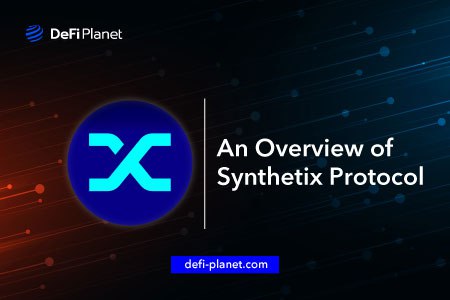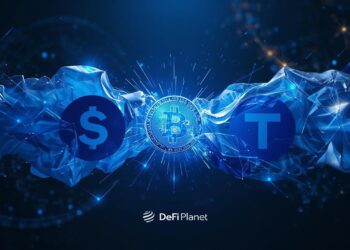As the crypto space expands, new types of assets emerge, such as synthetic or derivative assets. The value of this type of crypto asset is derived from the underlying cryptocurrency or other assets that it represents.
Due to the illiquidity of Proof of Stake networks, synthetic assets have increased in popularity. Some synthetic issuance protocols provide this type of asset to those who want to stake their token but do not want to deal with the liquidity difficulties that are prevalent when staking on a PoS network.
This article provides a detailed overview of Synthetic Assets, The Synthetix Protocol, How the Synthetix Protocol works and the Synthetix Network Token (SNX).
What are Synthetic Assets?
Synthetic assets are derived from either cryptocurrencies or traditional assets. They are also called tokenized derivatives.
In traditional finance, the term “derivative” refers to an asset that represents an underlying financial instrument that the holder does not own but intends to buy or sell.
The owner of a derivative is not required to own the underlying token before they can buy or sell it. This logic also applies to the synthetic assets that are available in the Decentralized Finance (DeFi) space. Holders can use synthetic assets to tokenize any cryptocurrency they choose without having to hold the underlying token and trade it.
Why Do People Hold Synthetic Assets?
People hold synthetic assets for different reasons, some of which will be explained below.
Liquidity
The rise of synthetic assets in the DeFi space has been linked to users’ seeking additional liquidity while staking their PoS tokens. Typically, a PoS network requires that those that hold the native tokens stake them, as a way of safeguarding the network. Staking comes with rewards, and when the process begins, the holder will be unable to access their tokens for some time. This means that their tokens are temporarily out of circulation for a while. It degenerates into illiquidity for that period.
Some synthetic asset issuance platforms, such as StaFi, offer synthetic assets to individuals staking their PoS tokens. When the tokenized derivatives are created, they are called rTokens. StaFi partners with major PoS networks to achieve this, and the number of its synthetic tokens seems to be on the rise. When Ether and Binance Coin are converted into rTokens, they become rETH and rBNB, respectively.
Typically, this type of protocol tends to allow its users to stake different types of PoS coins with them, then offer synthetic assets derived from these cryptocurrencies. This means that crypto holders can trade their synthetic assets, inject them into liquidity pools, lend them out, or engage in other DeFi activities while their underlying coins are still staked.
When the staking period is over, users can choose to return the synthetic assets and access their staked tokens and rewards. When synthetic assets are used in this case, users can stake, earn staking benefits, engage in DeFi activities, and earn rewards from those activities all at the same time.
Flexibility
Another reason for the increased demand for synthetic assets is the flexibility they provide. This type of asset is more flexible than traditional assets. A centralized exchange is known to provide more trading options compared to a decentralized exchange.
The former requires users to sign up and undergo a rigorous “Know Your Customer” (KYC) process, depriving them of their anonymity.
Synthetic assets are traded mostly on decentralized exchanges, and new synthetic asset exchanges offer privacy. Traders end up paying lower gas fees.
Tokenization
Synthetic assets were created to bring non-blockchain commodities to the blockchain. Its goal is to tokenize real-life assets so that crypto enthusiasts can trade them. For example, gold is not a blockchain-based asset, yet a user may want to trade it on the blockchain without holding the underlying gold. A synthetic asset issuance protocol may generate a tokenized derivative of gold that users could trade.
Unbridled access to assets
Users demand synthetic assets because they want access to certain assets without having to hold them. A crypto trader may want to trade a synthetic asset like gold or the Australian dollar, but they have no intention of buying these real-life assets. What do they do? They buy the tokenized derivative of this asset and trade it.
For instance, when a crypto trader buys sXAU from Synthetix, they have access to the price of gold without having to own gold.
Some cryptocurrency traders may not want to hold the underlying asset since it may be prohibitively expensive to purchase. Synthetic assets enable these underlying assets to become divisible, allowing users to exchange them seamlessly.
It could also be due to the difficulty of obtaining these assets. There may be restrictions limiting the purchase of real-life assets by the government in a region. A trader can decide to circumvent these restrictions by purchasing synthetic assets instead of real-life assets.
Asset Disposal
Aside from the aforementioned reasons, it could be due to a lack of flexibility in disposing of the asset. Gold, for example, is precious, but it is not as liquid as cash or regular cryptocurrency. If a trader wants to sell their token, they can do so quickly on an exchange. Gold, on the other hand, is a different story. Finding a buyer takes time. It may also come with specific requirements that the seller must fulfill while disposing of it. Disposing of a synthetic asset, on the other hand, is relatively simple.
Synthetix: A Short Origin Story
Kain Warwick created Synthetix in 2018 as Haven. Haven was founded to produce digital assets that could function like fiat currencies. Haven was later renamed Synthetix and expanded its operations to generate synthetic assets.
During the rebranding process, the governance system was also changed from a non-profit to a Decentralized Autonomous Organization (DAO). To participate in the Synthetix governance system, users must hold the platform’s native token, SNX. They can use it to make proposals and vote on modifications.
Synthetix Protocol: The Big Picture
You can think of Synthetix as a protocol for decentralized synthetic assets. If you’re not familiar with the term “synthetic asset,” it’s essentially a financial instrument that closely tracks the price of something else: gold, oil, bitcoin, etc. Synthetix is like Bitcoin in that it provides an open protocol for value exchange. But rather than creating a decentralized payment network like Bitcoin does, which primarily focuses on transactions (i.e., sending money from one person to another), Synthetix allows anyone to create synthetic assets and trade them with one another peer-to-peer without having to go through any intermediaries (i.e., banks). This opens up many more possibilities beyond just payments; for example, contracts could be created where someone would receive $1 if Apple stock goes down by 5% over the next month—and vice versa if it increases instead! A decentralized derivatives market is now possible using DeFi protocols like Synthetix.
Synthetix is a DeFi Protocol that allows users to trade synthetic assets (some of which may be crypto or traditional commodities like gold) on the Ethereum blockchain. It converts an array of assets, such as cryptocurrencies, real-world commodities, inverses, indexes, and much more, into tokenized derivative instruments on Ethereum. When these assets are tokenized, they take the form of ERC20 tokens called Synths. Synthetic assets are created by minting them with SNX tokens, which are then locked up in a smart contract until the tokens are burned back into existence. Minted Synths may be traded for other Synths or an underlying asset.
With Synthetix, crypto traders have access to some assets that are not blockchain-based. Apart from the aforementioned, different types of indexes can be created, which track the prices of several assets.
Examples of synthetic crypto indexes are sDEFI and sCEX. The former tracks the value of several DeFi assets, while the latter does the same except that it is for centralized exchange tokens.
Components of the Synthetix Protocol
Synthetix enables users to unlock liquidity in any asset by creating derivatives markets using a synthetic representation of its value. The Synthetix Protocol has three primary components:
The Synthetix Exchange.
Typically, synthetic asset issuance protocols create decentralized exchanges where holders of their assets can trade them. This is to improve the liquidity of their tokenized derivatives.
In the case of Synthetix, it has a decentralized exchange, Kwenta, where users can trade their Synths. It is an Automated Market Maker (AMM), meaning that traders engage in peer-to-contract trading. On Kwenta, users can trade synthetic assets made from real-life assets like Australian and US dollars. They can also trade synthetic crypto assets and inverse assets. Like other AMMs, Kwenta depends on smart oracles to feed it the right prices.
Minting and Burning sUSD
Minting and Burning sUSD refers to how sUSD is created and destroyed in order to maintain a stable rate relative to US Dollars ($1 = 1 sUSD).
The Collateral Pool
The Collateral Pool is made up of an array of collateral types that are used as security by those wanting to mint sUSD — if they default on this obligation, they will lose their collateral and any open positions they have will be closed out by the network through liquidation auctions.
How the Synthetix Platform Works
The operation of the Synthetix platform can be divided into three main steps: Minting, Exchanging and Burning Synths.
Minting: Minting is done via the Synthetix protocol. When SNX holders put their tokens in a smart contract to be locked up, they gain the right to mint an unlimited number of Synths (as long as the Synth reserve rate has been met).
Exchanging: Synths can be exchanged through a decentralized exchange (DEX) using the Kyber Network Protocol. This DEX allows users to swap any ERC20 token for another ERC20 token with no fees, while maintaining full reserve transparency and decentralization.Synths can also be traded on the decentralized exchange created by Synthetix, Kwenta. Kwenta is an Automated Market Maker (AMM) built on Ethereum, which allows users to exchange any asset for another asset within the system. To ensure that the tokenized assets have value, they are backed by the native token of the ecosystem, SNX, or Synthetix Network Token.
Burning/repaying: In order to unlock SNX that were locked up during minting, SNX holders are required to burn sUSD equal in value to their minted Synths. In other words, for every 1 sUSD burned, 1 corresponding Synth is destroyed, and 1 SNX is returned from lockup.
What is Synthetix Network Token (SNX)?
The Synthetix Network Token (SNX) is the native token of Synthetix and possesses important utility in this ecosystem.
SNX is an important aspect of creating a Synth in Synthetix because it acts as collateral. Every Synth that is ever minted in this ecosystem is overcollateralized, meaning that its collateral amount is higher than its value.
To mint a Synth, the user must have collateral of SNX that is higher than the value of Synth they want to mint. Ether is also allowed as collateral for the minting process.
A collateralization ratio determines the amount of collateral that a user must maintain when minting and using a Synth. To avoid liquidation, the collateral amount should not fall below this amount. It was designed this way to act as a hedge.
In Conclusion,
- Synthetix is a DeFi protocol that issues synthetic assets.
- The synthetic assets could be inverse assets, crypto assets, or real-life assets.
- Synthetic assets provide access to the price of an asset without holding the underlying asset.
- Kwenta is the decentralized exchange of Synthetix.
- SNX is the native token of Synthetix, which is used to unlock the features of this ecosystem.
- Before a synthetic asset can be minted, the user must provide collateral of SNX that is higher than the value of the asset.
- SNX can also be used in governance processes.
If you would like to read more articles like this, visit DeFi Planet and follow us on Twitter, LinkedIn, Facebook, and Instagram.
“Take control of your crypto portfolio with MARKETS PRO, DeFi Planet’s suite of analytics tools”





















